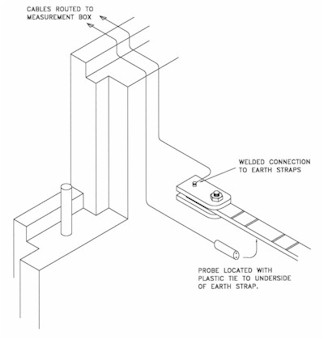These reinforced earth structures were constructed between 1988 and 1990 to carry trains into and from the Folkestone Terminus of the Channel Tunnel.
Three walls were designated for monitoring possible effects of current leakage from the overhead lines. These were the Brickpit structure as well as the North and South Fanwalls.
The elements at risk are the galvanised steel straps supporting the concrete segments. There are three straps per segment supported in tension and extending to around 30m into the sand/ soil infill. The area under maximum strain is believed to be the first 1 to 2m from the fixing point of the segment.
Failures are very rare, although have been known to occur, with the failure mode as predicted in classical corrosion theory to be at the point of most stress.
It should be emphasised that an isolating barrier from the
overhead lines exists within the construction in the form of a waterproof membrane system
and that all straps are below this insulating level. Any pick-up from stray current would
therefore be associated with defects in the insulating membrane, perhaps, occurring during
construction or arising from any degradation of the membrane with time.
Moreover, careful consideration was given to earthing and the return paths for track current within the electrical designs.
Nevertheless, a buried early detection corrosion monitoring system (designed, supplied, installed and commissioned by MCT- Materials and Corrosion Technology Ltd. and superceded by C-Probe Technologies Ltd.) was installed along the reinforced earth structures at various depths to provide comfort that no significant interference was being experienced.

Corrosion Measurement Arrangement
All monitoring probes were located at the most vulnerable section some 1.5m from the segmental fixings and at varying depths from close to the insulating membrane to close to the bottom of the reinforced earth walls.
The probes were manufactured so as to provide a three-electrode assembly to allow both corrosion potential and corrosion current (rate) to be assessed. The probes have now been operating successfully for over 10 years.
The monitoring locations were installed to allow assessment of all 3 straps in the designated segment. In total, 28 locations were installed for the Brickpit structure, 17 locations for the North Fanwall and 7 locations for the South Fanwall. This represents a monitoring location approximately every 20 linear metre length of wall.
The monitoring principle was to cross-compare any effects along the length of the wall as well as between points to establish any trends in corrosion effect to the location along the wall where they may more prevalent.
All locations were installed during the construction phase and completed in 1990.
 |
 |
 |